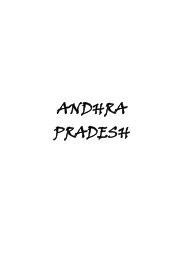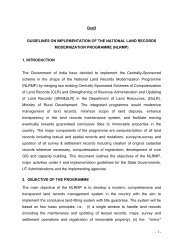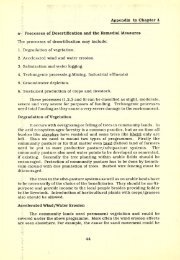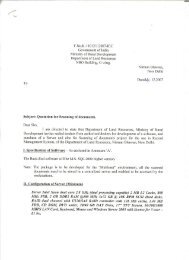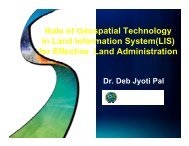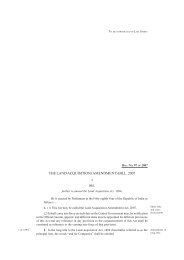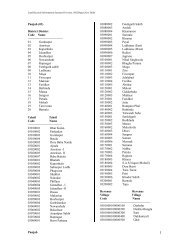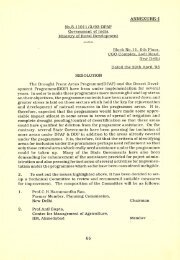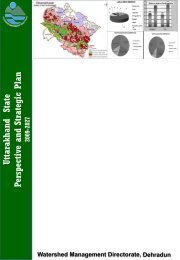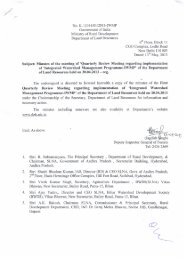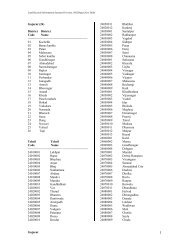Table 2 - Department of Land Resources
Table 2 - Department of Land Resources
Table 2 - Department of Land Resources
You also want an ePaper? Increase the reach of your titles
YUMPU automatically turns print PDFs into web optimized ePapers that Google loves.
Introduction<br />
The Government <strong>of</strong> India took early note, way back in 1988-89, for the requirements <strong>of</strong><br />
the Information System for <strong>Land</strong> Records Management <strong>of</strong> the county. Management <strong>of</strong><br />
land records and the associated issues are the responsibilities <strong>of</strong> the respective State<br />
Governments. The evolution <strong>of</strong> land management is a long process and has roots in<br />
historical times <strong>of</strong> India and the documents and process invariably vary from region to<br />
region and State to State. NIC was chosen as Information Technology Consultant to<br />
prepare the Information System as per the needs <strong>of</strong> the State and support the necessary<br />
Information Communication Technology (ICT) infrastructure at various levels.<br />
Respective NIC State units prepared (studied the system, developed and maintained) the<br />
s<strong>of</strong>tware package suiting to State specific need and the same information system is being<br />
implemented in more then 500 districts and 4000 tehsils/taluks. This information system<br />
is catering to the needs <strong>of</strong> the citizen with reference to collection <strong>of</strong> the basic land records<br />
documents like the certified copy <strong>of</strong> Records <strong>of</strong> Right (ROR) and crop/revenue details <strong>of</strong><br />
the land parcel. These documents are maintained in various formats as prescribed by the<br />
State Government and are identified by various names like P1, Adangal Pahani, Khatoni,<br />
khata, Jamabandi, chitta and 7/12. These manuals /registers vary from State to State with<br />
respect to record keeping and updation.<br />
Government <strong>of</strong> India decided in 2008 to merge the then Computerisation <strong>of</strong> <strong>Land</strong><br />
Records (CLR) and Strengthening <strong>of</strong> Revenue Administration and Updating <strong>of</strong> <strong>Land</strong><br />
Records (SRA&ULR) under a new scheme in the name <strong>of</strong> National <strong>Land</strong> Records<br />
Modernization Programme (NLRMP). This integrated programme would modernize<br />
management <strong>of</strong> land records, minimize the scope <strong>of</strong> the land disputes, enhance<br />
transparency in the land records maintenance system and facilitate moving eventually<br />
towards guaranteed conclusive titles to immovable properties in the country.<br />
This integrated programme would eventually modernize land records management,<br />
reduce workload and minimize manipulations, land disputes and moving to guarantee<br />
conclusive title to immovable properties in long term. The major components <strong>of</strong> the<br />
programme are computerization <strong>of</strong> land records, digitization <strong>of</strong> existing cadastral maps,<br />
inclusion <strong>of</strong> maps with RoR and maps, undertaking survey/resurvey to depict true ground<br />
positions and boundaries, automation <strong>of</strong> registration process, integration <strong>of</strong> registration<br />
process with mutation for updation <strong>of</strong> records and strengthening the capacities <strong>of</strong> revenue<br />
and registration staff to handle new instruments/equipments and technologies.<br />
Computerisation <strong>of</strong> <strong>Land</strong> Records has been in practice for quite some time now and<br />
various states have already made significant headway in this regard. While Record Of<br />
Rights (RoR) data has been converted to electronic form by many states long back, the<br />
preservation and manipulation <strong>of</strong> Parcel maps on electronic media had been eluding due<br />
to cost and technology constraints till recent past. Though some states have taken<br />
initiative in this matter the solution provided by them was limited to scanning and<br />
printing the maps or generating the MIS reports based on digitized maps. The real need<br />
was to have a mechanism not only to store and secure the digitized maps but also to edit<br />
them to reflect the actual changes arising out <strong>of</strong> mutations.<br />
NIC,Deity,MCIT,GOI DOLR,MORD,GOI 119




